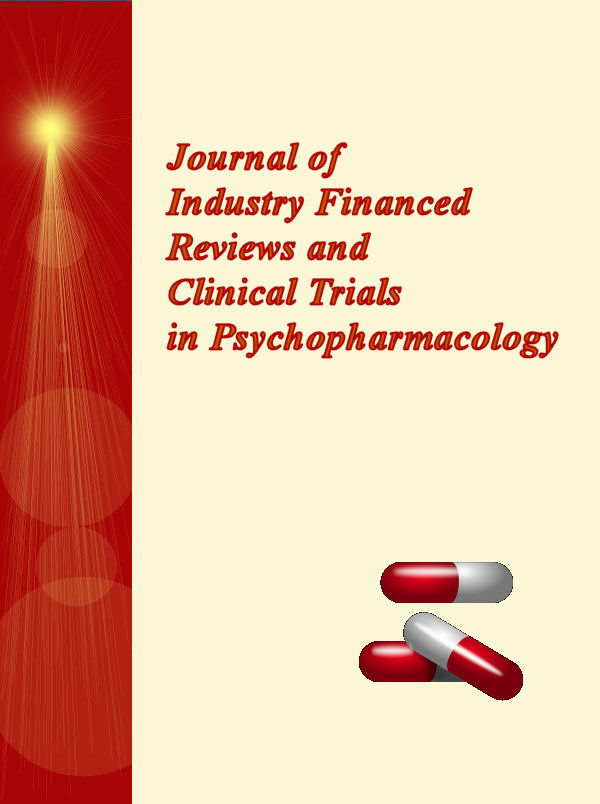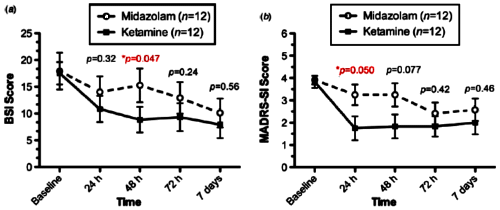 I have no real information about Ketamine as a treatment for depression, though it does seem beyond peculiar to be writing about a club drug in the context of treating a mental illness. But I’m writing about it for another reason nonetheless – a ethical reason. As common as it has become, I protest peer reviewed academic journals publishing articles that are primarily commercials. And my protest extends to publishing articles written by people with strong financial ties to the treatment under discussion in the article. It would be fine with me if there were a specific journal for that kind of paper – the Journal of Industry Financed Reviews and Clinical Trials in Psychopharmacology. I expect there already are a few [or some unacknowledged candidates].
I have no real information about Ketamine as a treatment for depression, though it does seem beyond peculiar to be writing about a club drug in the context of treating a mental illness. But I’m writing about it for another reason nonetheless – a ethical reason. As common as it has become, I protest peer reviewed academic journals publishing articles that are primarily commercials. And my protest extends to publishing articles written by people with strong financial ties to the treatment under discussion in the article. It would be fine with me if there were a specific journal for that kind of paper – the Journal of Industry Financed Reviews and Clinical Trials in Psychopharmacology. I expect there already are a few [or some unacknowledged candidates].
by J. W. Murrough L. Soleimani, K. E. DeWilde, K. A. Collins, K. A. Lapidus, B. M. Iacoviello, M. Lener1, M. Kautz, J. Kim, J. B. Stern, R. B. Price, A. M. Perez, J. W. Brallier, G. J. Rodriguez, W. K. Goodman, D. V. Iosifescu and D. S. Charney.Psychological Medicine. 2015 45:3571–3580.
Background. Suicide is a devastating public health problem and very few biological treatments have been found to be effective for quickly reducing the intensity of suicidal ideation [SI]. We have previously shown that a single dose of ketamine, a glutamate N-methyl-D-aspartate [NMDA] receptor antagonist, is associated with a rapid reduction in depressive symptom severity and SI in patients with treatment-resistant depression.Method. We conducted a randomized, controlled trial of ketamine in patients with mood and anxiety spectrum disorders who presented with clinically significant SI [n = 24]. Patients received a single infusion of ketamine or midazolam [as an active placebo] in addition to standard of care. SI measured using the Beck Scale for Suicidal Ideation [BSI] 24 h posttreatment represented the primary outcome. Secondary outcomes included the Montgomery–Asberg Depression Rating Scale – Suicidal Ideation [MADRS-SI] score at 24 h and additional measures beyond the 24-h time-point.Results. The intervention was well tolerated and no dropouts occurred during the primary 7-day assessment period. BSI score was not different between the treatment groups at 24 h [p = 0.32]; however, a significant difference emerged at 48 h [p = 0.047]. MADRS-SI score was lower in the ketamine group compared to midazolam group at 24 h [p = 0.05]. The treatment effect was no longer significant at the end of the 7-day assessment period.Conclusions. The current findings provide initial support for the safety and tolerability of ketamine as an intervention for SI in patients who are at elevated risk for suicidal behavior. Larger, well-powered studies are warranted.Declarations of Interest:
In the past 3 years, Dr Murrough has served on advisory boards for … and is named on a patent pending for neuropeptide Y as a treatment for mood and anxiety disorders, on a patent pending for the combination of ketamine and lithium to maintain the antidepressant response to ketamine, and on a patent pending for the combination of ketamine and lithium for the treatment Ketamine for suicidal ideation… … Dr Charney [Dean of Icahn School of Medicine at Mount Sinai], and Icahn School of Medicine at Mount Sinai have been named on a use patent on ketamine for the treatment of depression. The Icahn School of Medicine has entered into a licensing agreement for the use of ketamine as therapy for treatment-resistant depression. Dr Charney and Icahn School of Medicine at Mount Sinai could potentially benefit if ketamine were to gain approval for the treatment of depression. Dr Charney is named on a patent pending for ketamine as a treatment for PTSD…
… Dr Charney [Dean of Icahn School of Medicine at Mount Sinai], and Icahn School of Medicine at Mount Sinai have been named on a use patent on ketamine for the treatment of depression. The Icahn School of Medicine has entered into a licensing agreement for the use of ketamine as therapy for treatment-resistant depression. Dr Charney and Icahn School of Medicine at Mount Sinai could potentially benefit if ketamine were to gain approval for the treatment of depression. Dr Charney is named on a patent pending for ketamine as a treatment for PTSD…
 It appears to me that an academic appointment is generally a requirement to publish an article in a peer reviewed academic journal [there’s good reason for that]. I’ve called it a ticket, one that has, in my opinion, been heavily abused – bought and sold way too frequently. An academic appointment isn’t intended to be a commercial commodity.
It appears to me that an academic appointment is generally a requirement to publish an article in a peer reviewed academic journal [there’s good reason for that]. I’ve called it a ticket, one that has, in my opinion, been heavily abused – bought and sold way too frequently. An academic appointment isn’t intended to be a commercial commodity.But here we have something even more confusing, both the academic author and his academy are on an entrepreneurial adventure. It doesn’t quite belong in an academic journal. But there doesn’t seem to be a traditional industry involved to get it into my proposed new journal. Maybe a better question to ask is, "What is Mount Sinai up to here?" Clearly it’s a potential money-making venture being spearheaded in consort with one of its academic department heads [or vice versa]. That being the case, are we to assume that this self-same department and its faculty are in any position to evaluate the drug’s effectiveness. And what does it say when the two articles on Ketamine are being touted by Department Chairmen [Nemeroff and Charney] who are notoriously KOLs heavily involved in commercial products?

How could this be supported by a university ethics board?
Ketamine seems to have some short term benefits on depression. So does cocaine.
@Ferrell – You beat me to it, except I was going to say heroin.
I think the principle is that any drug that can modify ongoing activity in a hyperactive circuit will give some relief of depression, at least temporarily. A good comparison is Parkinson’s disease, where ketamine has a very useful short term effect. Here is a case report, and there is much more for those who want to look into it.
If we consider the cortico-striato-thalamo-cortical circuits involved in mood regulation, structured much like the parallel circuits involved in motor regulation, there are multiple synaptic neurotransmitters involved. So, glutamate antagonists like ketamine can help for a brief period, as can opiates and stimulants as referenced above by Ferrell Varner and Joseph Arpaia. So, too, can anticholinergic drugs like benztropine in clinical trials. Some think that is the reason agents like amitriptyline were so good – that the anticholinergic activity teamed up with the noradrenergic and serotonergic reuptake blockade. Plus, dopamine blocking antipsychotic drugs – both first generation like thioridazine and later, second generation agents – have shown some activity in depressed patients. And then, of course, there are the GABA blockers like benzodiazepines and self-administered ethanol.
Each of these neurotransmitter tweaks has been worthy of study but they never panned out for effectiveness, despite positive initial signals. Ketamine will probably end up in the same place.
Oops… make that GABA agonists, not blockers, for benzos and alcohol.
I have also heard that you can hide Ketamine, cocaine, and heroin from law enforcement by throwing them way up high in the air– but alas, another short-term solution.
Ketamine seems like a bizarre choice for an antidepressant. Cocaine, heroin, even LSD– all bad ideas I can completely understand. But on the rare occasions ketamine made it to a loft party in the ’80s, I just remember everyone walking around the dance floor in complex geometric patterns.
No one seemed particularly depressed. But I met people who had taken it several times, and were completely incapable of explaining exactly what it did or how it made them feel.
Maybe that’s what it has in common with all the other antidepressants. (Except the older ones, which I’m told actually worked.)
@Ferrell
There’s a pretty big difference between something having a positive effect on depression by making someone high (cocaine) and having a positive but not lasting effect on depression afterwards as well. Ketamine’s supposed effects last about a week, and ketamine does not make you high for a week.
Also in general referring to it as a club drug is a bit questionable. It’s on the WHO list of essential medicines, after all. Plenty of prescription drugs are abused, but that doesn’t mean they aren’t medically useful as well. The fact that it happens to be taken recreationally doesn’t make it strange that people might talk about using it to treat things as well.
When is comes to recreational and quasi-recreational drugs, just the brain-scrambling alone may be enough to distract a study subject (who is also getting an unusual amount of supportive attention) from “suicidal ideation” (what is that?). But oh, the morning after…..
The mind is constantly organizing raw perceptions into recognizable perceptions leading up to a sense of self, others, and what has been called the generalized reality orientation. This is an inferential process. That is, given any set of sensory data there is an infinite number of reality orientations which will fit that data. This is definitely true for visual perception. See papers by Hoffman, Bennett, and Prakash, and their book Observer Theory, for a mathematical formulation of this. The key idea is that the “I” that is depressed is the product of a set of inferential processes and is not deductively valid. Therefore any intervention that disrupts the sense of “I” has the potential to relieve depression.
Ketamine is a dissociative agent. That means it causes a profound disruption in the processes that are involved in that creation of the “I”. If that leads to a shift in how those processes function, then an experience of “I” that is not depressed can arise. It will tend to last for awhile, but the external influences on the system will tend to push the system to the former equilibrium and the depression usually returns.
An analogous situation is a patient of mine who was quite depressed and travelled to Thailand for a week. She came back and is completely in remission from her depression. The experience caused a disruption in her sense of “I” and a new “I” arose that is not depressed. The problem is how to maintain that, which was the subject of our session. That is also the problem with ketamine.
There are non-pharmacologic techniques for disrupting those inferential processes (other than a trip to Thailand). Many of those involve processes to induce trance, and the context of the ritual can influence what arises out of the disruption, whether it is a healthier self or a cult member.
A physical analogy is an iron bar magnet. An iron magnet is composed of microscopic domains of atoms, each of which is roughly oriented the same way. If the magnet is heated up past the Curie Point, ~800 C, then the domains stop lining up and the bar is no longer a magnet. If at that temperature it is placed in an external magnetic field that is strong enough and cooled while the external field is maintained then the domains in the bar will line up with the external field and the bar will be magnetized, with the orientation of the external field, thus giving the possibility of shifting the north and south poles of the magnet.
External Field N ——– S
Bar Magnet Field S-N
Heat Bar
External Field N ——– S
Bar Magnet Field NONE
Cool Bar
External Field N ——– S
Bar Magnet Field N-S
The bar’s field now points in the opposite direction.
Certain dissociative processes, parmacologic or otherwise, act on the self like the temperature on the bar. The external context can influence what arises. So my prediction is that the current success with ketamine is partly due to the context of it being new, exciting, and being performed by people who believe strongly in its efficacy. If it becomes mainstream then the context will not be the same, like the external field not being that strong in the bar magnet analogy, and the results will not be nearly as robust.
Furthermore, having worked with professionals who were addicted to ketamine, it does have abuse potential, so caution is definitely advised.
No one would be talking about ketamine if our current antidepressants actually worked.
Tom,
Amen!!
I wonder about the education students in that medical school will receive.
In 2009, Dr. Charney and a colleague published an opinion piece in AJP,“Publication Bias and the Efficacy of Antidepressants.” (Am J Psychiatry 2009; 166:140-145). In it they called for academic “disease-focused clinical research centers” that would conduct “proof of concept” trials.
I had just finished Allison Bass’ “Side Effects” and Melody Peterson’s, “Our Daily Meds” and this fueled my anger and disillusionment.
I wrote a letter to the editor calling for academic psychiatrists to come forward to accept responsibility for the role they had played in inflating the efficacy of most psychiatric drugs.
It was published but the final line – which I stand – by was cut:
I am ashamed of and angry at my profession. Until people who have personally benefited from the marketing that has masqueraded as research take responsibility for their behaviors, I do not believe that the public should feel confident in their recommendations.